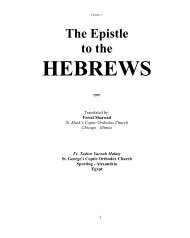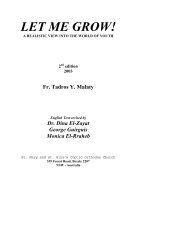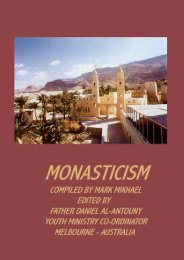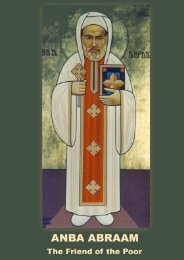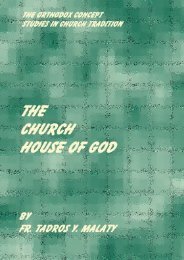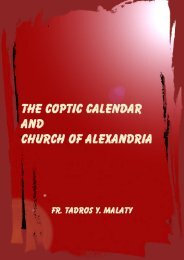the coptic contribution to christian civilisation - Fatherjacob.org
the coptic contribution to christian civilisation - Fatherjacob.org
the coptic contribution to christian civilisation - Fatherjacob.org
Create successful ePaper yourself
Turn your PDF publications into a flip-book with our unique Google optimized e-Paper software.
The primitive Coptic churches appear <strong>to</strong> have retained this tripledivision, which may still be witnessed in some of <strong>the</strong> his<strong>to</strong>ricchapels of <strong>the</strong> ancient convents. The innermost area behind <strong>the</strong>iconostasis was <strong>the</strong> sanctuary (haikal) where priests anddeacons alone were admitted <strong>to</strong> officiate <strong>the</strong> mystery of <strong>the</strong>Sacrament. Outside <strong>the</strong> sanctuary, <strong>the</strong> central part of <strong>the</strong> churchwas reserved for baptized Christians, while a third section at <strong>the</strong>entrance was left open for <strong>the</strong> unbaptised catechumens. Thisarchitectural arrangement fits <strong>the</strong> Coptic offices <strong>to</strong> perfection.Indeed <strong>the</strong> Coptic liturgy is subdivided in<strong>to</strong> three parts, namely,<strong>the</strong> liturgy of <strong>the</strong> catechumens, <strong>the</strong> liturgy of <strong>the</strong> faithful, and<strong>the</strong> Anaphora. Whereas <strong>the</strong> catechumens were expected <strong>to</strong>depart after <strong>the</strong> first stage, <strong>the</strong> screen was drawn after <strong>the</strong>second <strong>to</strong> conceal <strong>the</strong> mystery of sanctification of <strong>the</strong> PreciousBody and Blood before Holy Communion.At an unknown date, <strong>the</strong> distinction between <strong>the</strong> baptizedfaithful and <strong>the</strong> unbaptised catechumens began <strong>to</strong> disappearwith <strong>the</strong> elimination of <strong>the</strong> latter through <strong>the</strong> spread ofChristianity, and it became meaningless <strong>to</strong> retain <strong>the</strong> threetransverse divisions of <strong>the</strong> church. Instead <strong>the</strong> perpendiculartriple division of nave and aisles was substituted for <strong>the</strong>transverse sections of bygone days. In this way, <strong>the</strong> basilicalstyle began <strong>to</strong> assert itself in Coptic ecclesiastical architecture.St. Mena's ca<strong>the</strong>dral, built by Emperor Arcadius (395-408) in<strong>the</strong> district of Mareotis west of Alexandria, <strong>the</strong> ruins of <strong>the</strong>magnificent ca<strong>the</strong>dral at Ashmunayn in Middle Egypt, and <strong>the</strong>majestic churches of <strong>the</strong> Red and White Monasteries of St.Shenute at Suhug are fourth and fifth century examples of thisimminent change which was gradually adopted by <strong>the</strong> rest of <strong>the</strong>Christian world. It would, however, be a mistake <strong>to</strong> assume that<strong>the</strong> change was sudden even among <strong>the</strong> Copts. The irregularityof church forms in Old Cairo proves that <strong>the</strong> definitive style of<strong>the</strong> basilica must have been an extended process. But it is an29




